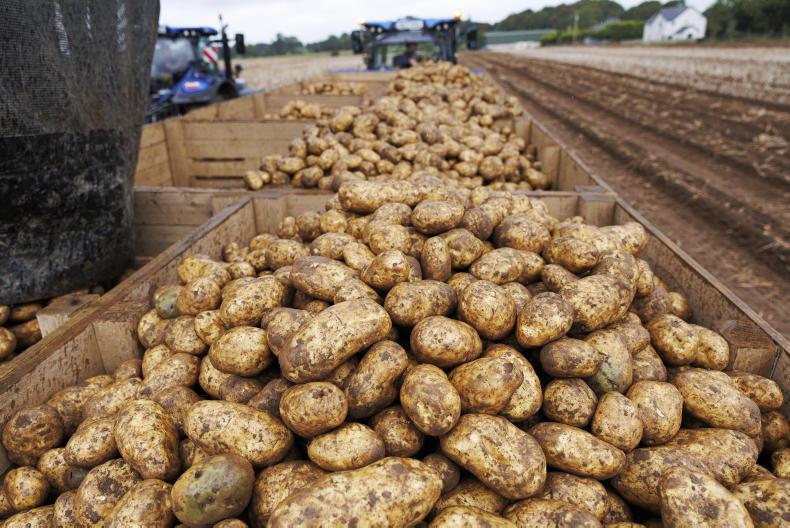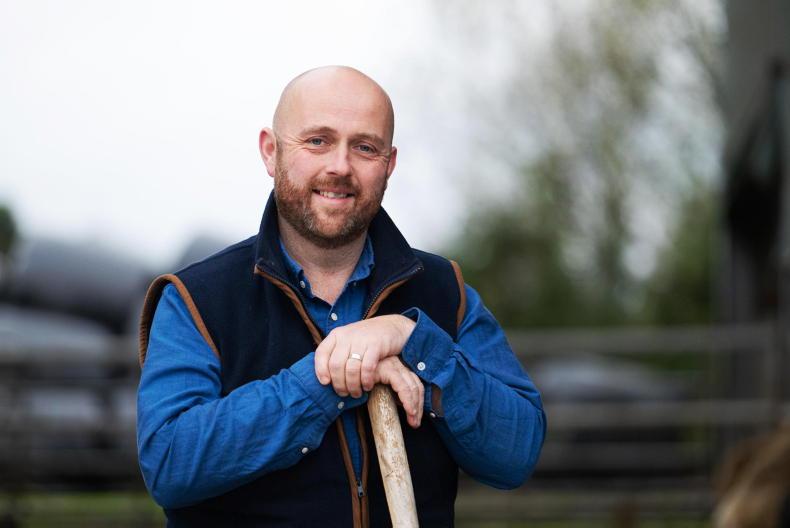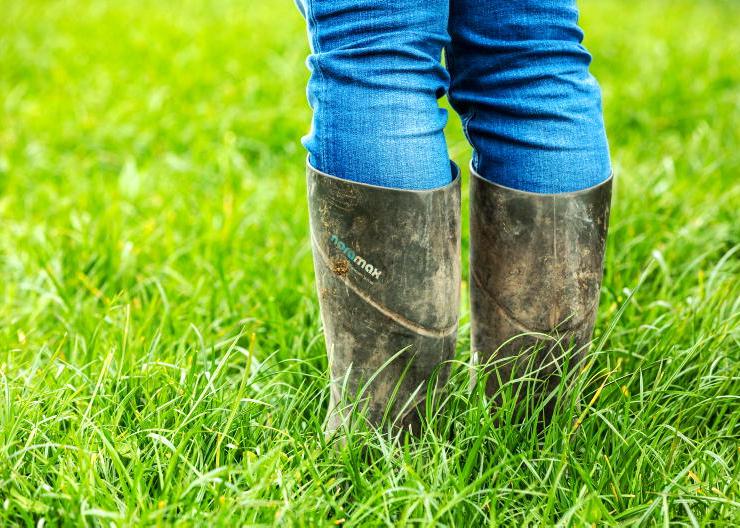Grass growth went from third gear to sixth gear on Saturday and Sunday as rain and much milder temperatures heralded the end of April and the start of May. Like clockwork; grass growth bounced, leaves came on the trees and the hedgerows bloomed.
The challenge now is to maintain grass quality so as to ensure high production over the next few months.
This starts with making sure there is enough high quality grass in front of the cows and cattle. The biggest risk is that grass covers get too strong. This results in too much stem, not enough leaf and a white or yellow base in the sward after grazing.
This will lower animal performance and restrict future growth rates, as these high covers take much longer to recover after being grazed.
Now that grass is plentiful you can do away with the strip wires and let cows and cattle have their fill over 24 or 36 hours before being moved on to the next paddock. Some farmers will keep cows on 12 hour breaks but one would need to be really sharp on allocations to get this right every time.
Cows are generally fed better and milk better when on 24 or 36 hour allocations. Post grazing residuals are closely correlated to pre-grazing yields. We’re looking for low residuals as this ensures nice leafy re-growth. Farmers should use a platemeter to occasionally measure residuals. Aim for between 3.5cm and 4cm.
Average grass growth rate is predicted to be 68kg/ha/day over the coming week. This is based on farms applying nitrogen so if working off reduced or no nitrogen, then these predicted growth rates can be reduced by almost 50%. There will be a good economic response to nitrogen over the coming weeks, even at high fertiliser prices.
Grass growth rates have taken off as weather has got milder. Grass growth is predicted to average 68kg/ha/day over the coming week. Make sure pre-grazing yields don’t go above 1,300kg to 1,500kg/ha by skipping over high paddocks for silage. Even though grass is growing well, make sure cows and cattle continue to graze out well as this will ensure good quality grass in the next rounds. Higher stocked farmers should be spreading 0.8 units per day of nitrogen i.e. 17 units/acre on a 21 day round. TJ Ryan – Rossmore, Co Tipperary
On the last walk cover was over 300kg/cow, so five paddocks were removed for silage. Some will be mowed next week and some will go in to long term silage, just to ensure I don’t run too tight on the milking platform.
One of these paddocks is marked for reseeding, so I’ll spray it off before mowing. Our first round of fertiliser was protected urea, followed by watery slurry post-grazing.
Last week I spread 21 units/acre of 27-2.5-5, which gave us a massive boost. I’ve oversown seven acres with Coolfin white clover at a rate of 3kg/acre over the weekend. This is part of our work with Teagasc Moorepark and the Heavy Soils Programme to reduce our N use.
Stocking Rate (cows/ha) 3.9
Growth Rate (kg/day) 70
Average Farm Cover (kg/cow) 230
Yield (l/cow) 29.5
Fat % 4.21
Protein% 3.42
Milk Solids (kg/cow) 2.32
Supplement fed (kg/cow/day) 2
Maeve Scally – Hilltop Farms, Co Roscommon
Grass has shot up in the past few days, so we’ve closed off three paddocks for silage to be mowed out over the weekend or early next week. We’re following the cows with urea, slurry or 18-6-12 based on our soil sample results.
We’ve pulled the rotation length back to 20 days, with 11 days grass still ahead of us. We’re just finishing off the second round now, with cows cut back this week from 3kg concentrates to 2kg.
All heifers got fixed time AI on the 27 April and 80% of the cows will be getting sexed semen on this farm, with the rest getting conventional semen. Cows are milking well.
Stocking Rate (cows/ha) 3.95
Growth Rate (kg/day) 72
Average Farm Cover (kg/cow) 166
Yield (l/cow) 29
Fat % 4.31
Protein% 3.67
Milk Solids (kg/cow) 2.38
Supplement fed (kg/cow/day) 2
Barry Reilly – Teagasc Ballyhaise, Co Cavan
Growth and demand are both at around 60kg/DM/ha at the moment, with 25% of paddocks having been taken out for reseeding.
Paddocks have been sprayed off and will be power harrowed with seed drilled in at the same time.
The varieties we are using as part of the trial are Glenfield, Aston Energy and Aston Conquerer (two tetraploids and one diploid).
Breeding is due to start on Monday, which is slightly later than most farms. We have been recording heats pre-breeding with strong heats recorded from both cows and heifers.
The majority of the herd will be AI’d with sexed semen.
Stocking Rate (cows/ha) 3.34
Growth Rate (kg/day) 60
Average Farm Cover (kg/cow) 190
Yield (l/cow) 26
Fat % 4.34
Protein% 3.64
Milk Solids (kg/cow) 2.14
Supplement fed (kg/cow/day)
Derek O’Donoghue – Salesian Agricultural College, Pallaskenry
We now have too much grass, a good complaint. Two more paddocks have been marked for silage and will be let grow to increase stocking rate on the grazing ground.
Triplet bearing ewes had been grazing away from the rest of the flock and were supplemented with concentrate for the first three weeks post-lambing. They have now joined the rest and are mixed-grazing with the heifers.
Less grazing groups makes grass management easier and increases the grazing power of each group, so residency time in paddocks is reduced.
Pre-grazing yields are high at 1,600kgDM/ha but now that there are bigger grazing groups and with extra ground taken out of the rotation this will be rectified in the coming week.
System Dairy calf to beef & sheep
Soil type Free draining
Farm cover (kg DM/ha) 684
Growth (kg DM/ha/day) 42
Demand (kg DM/ha/day) 34
Declan Marren – THRIVE Farm Cashel
Growth has kicked on in the last week. Ground that has been grazed is coming back quickly and I expect the growth figure to increase again next week.
There is 43% of the farm closed for first cut silage, with a target cutting date of 20 May. Five paddocks on the grazing block have been closed for silage and are being allowed to grow for another week prior to harvest.
The grazing ground received 27 units/acre of nitrogen last week, the second application of the year. The focus over the coming weeks is to keep yearling stock entering covers of 1,400kgDM/ha and maintain grass quality to hit a 4cm residual grazing sward height. The oldest calves are now at grass full-time and will be weaned by the weekend.
System Dairy calf to beef
Soil type Mostly dry
Farm cover (kg DM/ha) 887
Growth (kg DM/ha/day) 41
Demand (kg DM/ha/day) 39
Niall O’Meara – Killimor Co Galway
Of the 45 paddocks on farm, 13 have been closed for silage. Another two look like they will be too strong by the time I get to them and will also be cut for silage. I fertilise all paddocks for grazing and then top them up with another 20 units/acre of nitrogen once they have been allocated to silage.
This week I am oversowing 10 acres with clover using a Güttler machine. These paddocks had a low percentage of clover and so were identified for oversowing. Soil fertility has been corrected over the last few years with the latest soil sample results showing 100% of the farm is index 3 or 4 for phosphorus and 80% of the farm is index 3 or 4 for potassium with the remaining 20% index 2.
System Suckler to weanling
Soil type Variable
Farm cover (kg DM/ha) 700
Growth (kg DM/ha/day) 72
Demand (kg DM/ha/day) 50
Grass growth went from third gear to sixth gear on Saturday and Sunday as rain and much milder temperatures heralded the end of April and the start of May. Like clockwork; grass growth bounced, leaves came on the trees and the hedgerows bloomed.
The challenge now is to maintain grass quality so as to ensure high production over the next few months.
This starts with making sure there is enough high quality grass in front of the cows and cattle. The biggest risk is that grass covers get too strong. This results in too much stem, not enough leaf and a white or yellow base in the sward after grazing.
This will lower animal performance and restrict future growth rates, as these high covers take much longer to recover after being grazed.
Now that grass is plentiful you can do away with the strip wires and let cows and cattle have their fill over 24 or 36 hours before being moved on to the next paddock. Some farmers will keep cows on 12 hour breaks but one would need to be really sharp on allocations to get this right every time.
Cows are generally fed better and milk better when on 24 or 36 hour allocations. Post grazing residuals are closely correlated to pre-grazing yields. We’re looking for low residuals as this ensures nice leafy re-growth. Farmers should use a platemeter to occasionally measure residuals. Aim for between 3.5cm and 4cm.
Average grass growth rate is predicted to be 68kg/ha/day over the coming week. This is based on farms applying nitrogen so if working off reduced or no nitrogen, then these predicted growth rates can be reduced by almost 50%. There will be a good economic response to nitrogen over the coming weeks, even at high fertiliser prices.
Grass growth rates have taken off as weather has got milder. Grass growth is predicted to average 68kg/ha/day over the coming week. Make sure pre-grazing yields don’t go above 1,300kg to 1,500kg/ha by skipping over high paddocks for silage. Even though grass is growing well, make sure cows and cattle continue to graze out well as this will ensure good quality grass in the next rounds. Higher stocked farmers should be spreading 0.8 units per day of nitrogen i.e. 17 units/acre on a 21 day round. TJ Ryan – Rossmore, Co Tipperary
On the last walk cover was over 300kg/cow, so five paddocks were removed for silage. Some will be mowed next week and some will go in to long term silage, just to ensure I don’t run too tight on the milking platform.
One of these paddocks is marked for reseeding, so I’ll spray it off before mowing. Our first round of fertiliser was protected urea, followed by watery slurry post-grazing.
Last week I spread 21 units/acre of 27-2.5-5, which gave us a massive boost. I’ve oversown seven acres with Coolfin white clover at a rate of 3kg/acre over the weekend. This is part of our work with Teagasc Moorepark and the Heavy Soils Programme to reduce our N use.
Stocking Rate (cows/ha) 3.9
Growth Rate (kg/day) 70
Average Farm Cover (kg/cow) 230
Yield (l/cow) 29.5
Fat % 4.21
Protein% 3.42
Milk Solids (kg/cow) 2.32
Supplement fed (kg/cow/day) 2
Maeve Scally – Hilltop Farms, Co Roscommon
Grass has shot up in the past few days, so we’ve closed off three paddocks for silage to be mowed out over the weekend or early next week. We’re following the cows with urea, slurry or 18-6-12 based on our soil sample results.
We’ve pulled the rotation length back to 20 days, with 11 days grass still ahead of us. We’re just finishing off the second round now, with cows cut back this week from 3kg concentrates to 2kg.
All heifers got fixed time AI on the 27 April and 80% of the cows will be getting sexed semen on this farm, with the rest getting conventional semen. Cows are milking well.
Stocking Rate (cows/ha) 3.95
Growth Rate (kg/day) 72
Average Farm Cover (kg/cow) 166
Yield (l/cow) 29
Fat % 4.31
Protein% 3.67
Milk Solids (kg/cow) 2.38
Supplement fed (kg/cow/day) 2
Barry Reilly – Teagasc Ballyhaise, Co Cavan
Growth and demand are both at around 60kg/DM/ha at the moment, with 25% of paddocks having been taken out for reseeding.
Paddocks have been sprayed off and will be power harrowed with seed drilled in at the same time.
The varieties we are using as part of the trial are Glenfield, Aston Energy and Aston Conquerer (two tetraploids and one diploid).
Breeding is due to start on Monday, which is slightly later than most farms. We have been recording heats pre-breeding with strong heats recorded from both cows and heifers.
The majority of the herd will be AI’d with sexed semen.
Stocking Rate (cows/ha) 3.34
Growth Rate (kg/day) 60
Average Farm Cover (kg/cow) 190
Yield (l/cow) 26
Fat % 4.34
Protein% 3.64
Milk Solids (kg/cow) 2.14
Supplement fed (kg/cow/day)
Derek O’Donoghue – Salesian Agricultural College, Pallaskenry
We now have too much grass, a good complaint. Two more paddocks have been marked for silage and will be let grow to increase stocking rate on the grazing ground.
Triplet bearing ewes had been grazing away from the rest of the flock and were supplemented with concentrate for the first three weeks post-lambing. They have now joined the rest and are mixed-grazing with the heifers.
Less grazing groups makes grass management easier and increases the grazing power of each group, so residency time in paddocks is reduced.
Pre-grazing yields are high at 1,600kgDM/ha but now that there are bigger grazing groups and with extra ground taken out of the rotation this will be rectified in the coming week.
System Dairy calf to beef & sheep
Soil type Free draining
Farm cover (kg DM/ha) 684
Growth (kg DM/ha/day) 42
Demand (kg DM/ha/day) 34
Declan Marren – THRIVE Farm Cashel
Growth has kicked on in the last week. Ground that has been grazed is coming back quickly and I expect the growth figure to increase again next week.
There is 43% of the farm closed for first cut silage, with a target cutting date of 20 May. Five paddocks on the grazing block have been closed for silage and are being allowed to grow for another week prior to harvest.
The grazing ground received 27 units/acre of nitrogen last week, the second application of the year. The focus over the coming weeks is to keep yearling stock entering covers of 1,400kgDM/ha and maintain grass quality to hit a 4cm residual grazing sward height. The oldest calves are now at grass full-time and will be weaned by the weekend.
System Dairy calf to beef
Soil type Mostly dry
Farm cover (kg DM/ha) 887
Growth (kg DM/ha/day) 41
Demand (kg DM/ha/day) 39
Niall O’Meara – Killimor Co Galway
Of the 45 paddocks on farm, 13 have been closed for silage. Another two look like they will be too strong by the time I get to them and will also be cut for silage. I fertilise all paddocks for grazing and then top them up with another 20 units/acre of nitrogen once they have been allocated to silage.
This week I am oversowing 10 acres with clover using a Güttler machine. These paddocks had a low percentage of clover and so were identified for oversowing. Soil fertility has been corrected over the last few years with the latest soil sample results showing 100% of the farm is index 3 or 4 for phosphorus and 80% of the farm is index 3 or 4 for potassium with the remaining 20% index 2.
System Suckler to weanling
Soil type Variable
Farm cover (kg DM/ha) 700
Growth (kg DM/ha/day) 72
Demand (kg DM/ha/day) 50









SHARING OPTIONS